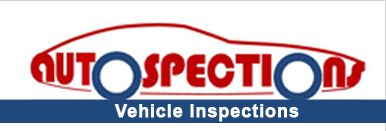Services
At Autospections we are all about convenient personal service.
You will deal with the same person from booking right through to the completion of the inspection.
Outline of what we do and what we don't do
Autospections are not equipped to inspect imported Exotics, Motorcycles, trucks or the electronic components of Hybrids. All inspections require a sealed, flat area on private property where the vehicle can be jacked up safely. Inspections cannot be carried out on the roadside or in public areas. If the vehicle licence has expired or has been suspended, then a road test cannot be carried out.
A SUPERCHECK or MECHCHECK provides an insight to the general condition of a motor vehicle. The Inspection Report relates to the condition of the vehicle at the time of the inspection. The inspection is based on the external examination of assemblies only. Assemblies are not dismantled to examine internal parts. The vehicle is assessed by such factors as noise, operation and performance.
The report indicates only the faults actually found, or reasonably capable of being found, at the time of the inspection. Autospections does not warrant that any other faults in the vehicle do not exist, other than those indicated in this report. It's not possible to report on a fault if we can't detect it during the inspection or road test. This report may indicate that a fault exists, but not provide any further information about it. This is because further dismantling may be required to provide accurate diagnosis. The condition of the vehicle can change with normal wear and tear, driver abuse, neglect, or unforeseen deterioration of some internal components. Where engines and other mechanical assemblies have been cleaned prior to inspection, it may not be possible for us to detect oil leakage. If the service history of the vehicle is unknown, we suggest you have all the oils, fluids and filters changed. Some additives may mask engine wear, therefore it’s advisable to operate the engine using lubricants as recommended the manufacturer.
ROAD TEST The road test provides a valuable method to assess the overall performance and drivability of the vehicle under operating conditions. The engine, transmission, brakes, steering and suspension are assessed for performance and noise. The speedometer is checked for operation, but not accuracy. A road test is conducted only if the vehicle is roadworthy and only up to the local speed limit.
ENGINE AND ASSOCIATED EQUIPMENT The condition and performance of the engine is assessed audibly for abnormal mechanical noise and visually for oil-smoke. Oil consumption cannot be measured during the inspection. Oil use can only be determined by operating the vehicle over an extended distance. If any oil burning is suspected, we suggest that a controlled oil consumption test be conducted. If the vehicle is under warranty, the dealer should be informed of the test. A catalytic converter can prevent oil smoke being detected. Some engines exhibit noises which are characteristic of the model, and the report will indicate when such noises are considered excessive. The cooling system is pressure tested where possible and assessed by an external examination of the radiator, radiator cap, hoses, water pump and drive belt. The engine cylinder head and block are checked externally for signs of failure, but the internal coolant passages cannot be inspected for corrosion or build-up of deposits. If the temperature gauge or warning lamp shows an overheating condition, this may indicate an internal fault requiring further investigation. The cooling system hoses tend to deteriorate from the inside. If you purchase an older vehicle, it is advisable to renew all hoses and flush the cooling system then refill with the manufacturer's recommended corrosion inhibitor/antifreeze. The exhaust system is checked for signs of leakage, impact damage, security of mountings and advanced corrosion. Exhaust systems can corrode from the inside, and the extent of any internal corrosion may not be detectable during the inspection. Most modern engine designs make a conventional compression test impractical, and test results can be misleading. This test is not included as part of a vehicle inspection. We believe it is unnecessary to measure cylinder pressures to establish if there is a problem and rely on other means of assessing engine condition. An engine which has a cylinder compression problem generally displays symptoms such as rough running or a distinct misfire, particularly at low rpm, and may also show excessive piston ring blow-by and signs of oil burning.
If a CAMBELT/TIMING BELT is fitted to the engine, we suggest that you check service records to ensure it has been replaced as per manufacturer’s recommendation.
TRANSMISSION The transmission system is examined externally for signs of damage and oil leakage. The operation is checked during the road test for abnormal noises and gear changes, which may indicate excessive wear of internal components. Driveline joints are checked for wear. In some vehicles, operational noises are encountered. These are sometimes noticeable only within a certain speed range and may be characteristic of the model. Where such noises are noticeable, the report will indicate if they are considered excessive.
SUSPENSION & STEERING The suspension, steering and driveline components, including chassis and subframes, are examined for damage, corrosion and wear. Ball joints and bushes are checked for abnormal movement and damage to protective boots. Shock absorbers are checked for damage, leakage and security of mountings. The steering system is checked for excessive free play, binding or harshness. Power steering components are checked for fluid leakage, operation, general wear and security of mountings. The wheel alignment is not measured.
BRAKES The brake components are examined for fluid leakage, damage and adjustment. The general operation is assessed during the road test. Provided special equipment is not required, wheels and brake drums are removed as necessary to determine the condition of brake linings, pads, drums and discs. In some cases park brakes will only be checked for function, and may not be visually inspected for condition. Seized components and hubs/drums with single use nuts are not removed. Because brake fluid deteriorates over time, it is advisable to replace it as recommended by the vehicle manufacturer. Where dual rear wheels are fitted, brake drums are not removed.
ABS (Antilock Braking System) cannot be fully checked without specialised test equipment.
WHEELS AND TYRES All tyres are examined for compliance, visible damage, mismatching and wear. The depth of remaining tread is measured and recorded (minimum legal tread depth is 1.5mm). Wheel rims are checked for damage and corrosion.
ELECTRICAL AND ANCILLARY EQUIPMENT (SUPERCHECK only) Electrical items are checked for operation and performance, but the accuracy of gauges and instruments are not checked. Visible wiring is examined for condition, safety and security. Air conditioning is checked for operation, abnormal noises, obvious leaks and security of components. Tape players, CD players, computerised equipment and accessories such as cruise control, security systems, electronic control units, radar detectors and telephones, are not included in this examination.
SRS (Supplemented Restraint System, Airbags) cannot be checked without specialised test equipment.
BODY (SUPERCHECK only) The examination of the body involves inspecting for rust, panel and paintwork damage, panel repairs and body panel alignment. The body/chassis alignment is not measured, no parts are removed and all comments are based on visual examination. The detection of external/body water leaks is not part of our inspection. Where a vehicle shows signs of major repairs, we will comment on the finish and areas of repair. Minor panel damage, paint chips and scratches may not be recorded. You should satisfy yourself in this respect. Fitted seat covers are not removed to check seat condition. Exterior items, including windows, door locks and mirrors are examined for damage and function. Window tint is not checked for compliance. A check of keys is not included in this inspection and we suggest you ensure that a full set is supplied at the time of purchase. The inspection of a camper van does not include the accommodation area and camping equipment such as fridge, stove, etc. The pop-up roof, seats and seat belts (if fitted) are checked.
|







